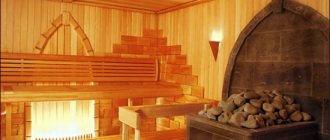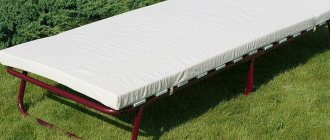When choosing coniferous trees for your site, you need to decide on two main criteria. Firstly, with the size of the coniferous composition and its purpose. Secondly, with a landscape design element in which this plant will be included.
In our country, thuja is not found in the natural environment; it came to us from America and East Asia
This coniferous plant turned out to be not capricious and has taken root well in northern latitudes.
Tall varieties of thuja
The conical and pyramidal forms of thuja differ from others in height. An impeccable hedge, capable of muffling the sounds of the street, protecting from gusts of wind, will close the area from the eyes of neighbors and passers-by. Arborvitae of these forms are usually planted in the background in landscape design. This makes it possible to plant lower and brighter shrubs against the backdrop of a green hedge. The result is a colorful composition.
Green island with pine needles Source www.dizainvfoto.ru
Option 5. Thuja in a flower bed
Bergenia, geranium, irises, petunias, poppies, hydrangeas, delphiniums, phlox, pansies, lilies, even primroses - this is not a complete list of successful neighbors for thuja.
Bright, lush-flowering annuals and perennials will be an excellent addition to any conifers, and thujas are no exception. Flowers look great against the background of a plain coniferous “wall”, both in groups and individually.
If you choose perennials, you will get a beautiful composition to suit your taste, but with annuals, every year you can update the flower garden with thujas to suit your mood, changing the “scenery”.
Western thuja varieties
Smaragd is a tree with a conical shape. The needles are emerald green, the crown is dense. Popular in cities with temperate climates because it is resistant to unstable weather. The growth rate is from 15 to 25 centimeters per year.
A mature tree is about six meters high. With the help of this variety, various compositions can be easily created, opening up scope for the creativity of the designer and gardener. You can create various shapes from Thuja Smaragd, be it a perfect cone or a spiral. You can plant a fence the length of the fence or divide the area into zones.
Thujas of different shapes Source www.botanichka.ru
Smaragd is a popular variety Source ecoplant-pitomnik.ru
Despite the fact that thuja Smaragd is not toxic and not dangerous to neighboring plants and animals, it quite strongly acidifies the soil. You cannot plant shrubs and fruit-bearing trees at a distance of less than 6 meters. It is better to use other coniferous plants in combination. Summer lilac and bamboo, rhododendron, hibiscus and cherry laurel take root well in the neighborhood.
Brabant is distinguished by its high growth rate and size. The height of an adult plant can reach 8 meters. The crown shape is cylindrical. The color is bright green, the tips are golden, which gives additional charm to the plant. Convenient to use as a living wall to divide an area into zones. Growing for decorative purposes will require additional labor, since the crown needs to be trimmed and shaped.
A variety of thuja Source www.ss.com
Brabant is grown mainly for hedges. It is important to maintain a distance between seedlings, which should be 0.5-0.7 meters. It is also good for creating various pieces, such as chess pieces.
Important! You cannot remove more than 30% of the needles when pruning and shaping the crown.
Aurea Nana is one of the shortest representatives. The young plant has an ovoid appearance, but as it grows it takes on a cone shape. The shoots are dense and have a yellow tint. The needles retain their green color with a golden tint throughout the year. The advantages of the variety include the compactness of the plant, the brightness of the colors and the arrangement of the branches, which is considered correct.
Thuja species orientalis pyramidalis aurea Source agro-landing.com.ua
Adult plants can easily tolerate frost, but young plants will need to be covered with spruce branches in the winter. Ideally in landscape design, this type of thuja will be planted in a small area or alpine hill.
Due to the fact that the variety is compact in size, it is excellent for low hedges. It is enough to plant trees at a close distance and wait for them to grow. There is no need to trim regularly. An original solution is to place a tree in the central part of a flower bed with red or blue flowers. It is very popular in small areas where there is little free space, but you want beauty and grace. You can plant heather, hydrangea, barberry, roses, and magnolias nearby.
Thuja orientalis aurea nana Source batanya.in.ua
Wagneri is a low variety, an adult plant reaches about 3.5 meters. This small tree has a conical-ovate crown. The branches are dense and point upward. And the light green color in the light of the sun begins to shimmer with a silver-metallic tint. Resistant to sub-zero temperatures, does not require shelter in cold weather. It is recommended to select a place in an area with good lighting, protected from strong gusts of wind. Suitable for gardening hedges. You can create compositions with herbaceous and coniferous plants.
Landscape design on a large plot Source romashkino.ru
Columna is one of the varieties that is ideal for green hedges, regardless of its purpose: zoning the territory or protecting it from prying eyes. The maximum plant height is 6 meters. Designers and experienced gardeners appreciate the variety for its high growth rate, does not require frequent watering, grows favorably even in dry places, is frost-resistant, and does not require much care. But this variety requires pruning in the spring to form a crown. Columna looks original in composition with other coniferous trees and stands out for its grace and color.
Maloniana is distinguished by its tortuosity of branches and has a columnar crown. The plant is fast growing and quite narrow. The needles are rich green in color and dense. It is distinguished by its slenderness and height, reaching 10 meters in an adult plant. Ideal for creating a hedge within the city. This variety quickly adapts to the urban environment and cleans the air from exhaust gases and dust. Flower beds with plants of rich and bright colors will look beautiful against the backdrop of Maloniana; roses and peonies look especially harmonious.
Thuja next to deciduous trees and shrubs
Thuja can look good not only with its coniferous neighbors. Deciduous trees and shrubs are also quite suitable for compositions with it. And the most diverse. Against the background of a hedge of conifers, forsythia, rhododendrons, spirea, ornamental willows, viburnum Buldenezh, bladderworts, derain, and low decorative-leaved apple trees will look good.
When choosing a deciduous plant that you are planning as a companion for an arborvitae, consider the time at which the leaves bloom and the plant begins to bloom, the duration of its flowering, the color of the flowers and leaves in summer and autumn. There are no trifles in such a choice; even what color the fruits will be matters.
So, as you can see, thuja is a grateful decorative neighbor for many types of herbaceous crops, trees and shrubs. You just need to correctly assess the potential of your site and do not forget to take into account the peculiarities of their agricultural technology when choosing companion plants for it.
Globular thujas
Thujas with a spherical crown are grown as an independent decoration, or in composition with representatives of other plants. Globular varieties do not need to form a crown. In rockeries and rock gardens, varieties no more than 0.8 meters tall are more often used. Such plants will combine beautifully with garden sculptures and add grace to the rocky scattering. Suitable for decorating a site. Most varieties do not require pruning or crown leveling.
Danica has the correct ball shape. The needles are bright and thick. An adult plant is about 70 centimeters high and can grow up to one meter wide. It is worth noting that the growth rate is low. But the plant is resistant to cold weather and can be planted in partial shade, because... not demanding on lighting. But experienced gardeners recommend providing it with a sunny area with fertilized soil for more fruitful growth. In such conditions, Danika's growth will be rapid. It will look harmonious on a site decorated in any style. It is very popular in Russia.
Landscape design could not do without this variety. It can be planted almost anywhere. It will look equally elegant on a hill of stones in a small garden, replace a border or serve as a decoration on the terrace, standing in a container. Looks good in flower beds among bright perennial flowers, also in mixed compositions.
Little Dorrit has a spherical crown with a slight elongation. The height of the plant can reach 80 centimeters, and the diameter of the crown does not exceed 0.7 meters. It will look harmonious both in ribbon compositions and when forming rockeries.
Globular bush - thuja western globosa Source www.nn.ru
Teddy - the variety appeared on the market relatively recently and in appearance looks like a prickly ball. The needles are small and needle-like. The Teddy variety grows at a low speed. The growth per year is approximately 3 centimeters, and an adult plant reaches no higher than 0.5 meters. In winter, the needles turn brown. Does not tolerate drought. If there is no rain in the evening, watering is required. Also, this variety is very demanding on the soil components; it must certainly be fertile. Often planted along alleys or gazebos. This approach allows you to fence off the recreation area.
Tiny Tim - flat needles, similar in appearance to feathers. It easily survives the cold, but does not tolerate poor lighting. Ideal for decorating with low-growing deciduous shrubs.
Golden thujas
Thujas with a golden color and the correct shape of the crown will look harmonious in any area. You can plant a single plant, grow it for additional decoration of flower beds with bright flowers, or add vibrancy to an area with sculptures and rocky scattering.
Reingold - maximum height 1.5 meters. The needles are yellow-golden in color, but turn brown in winter. Grows slowly, loves sunny areas. Looks impressive on the lawn without additional compositions.
Sunkist is a variety with a conical shape. This variety, like many others, grows slowly. After 10 years, the height of the plant can reach up to 3 meters. Requires regular watering and does not tolerate dry air.
Golden Taffet has golden needles that change color. When it gets cold, the color becomes almost orange. The variety is low growing. A mature plant is no higher than 35 centimeters. Thanks to the hanging shoots, the plant looks like a lace cap. It should not be planted in the shade, as the color of the needles begins to lose brightness and becomes dull. Only sunny areas. It will not grow well in unfertilized soil. It has a negative attitude towards drought, so it will need to be watered regularly. Good for creating borders. This thuja variety is often used in Japanese-style landscape design and in combination with dark green thujas.
Frost-resistant coniferous ornamental shrubs for the garden
For regions where winter conditions are quite harsh, growing frost-resistant crops is an excellent solution.
Let's look at three interesting options:
- Scots Pine Watereri. It has a rounded shape, quite thick and dense. The shade is gray-blue, forms 2 needles, their length is up to 4 centimeters. The crop is undemanding to soil, but does not grow on saline soil. Prefers sunny areas and is frost-resistant down to minus 30 degrees.
- Japanese Cryptomeria . It reaches a height of up to 6 meters. It has a cone-shaped crown. Can grow in both sun and shade. The shade of the needles is dark green, but with a slight bluish tint. Prefers to grow in acidic and moist soils. Able to withstand temperatures down to -23 degrees.
- Korean fir (Abies Koreana). Miniature conifer, distinguished by shiny and soft needles, develops slowly - up to 5 centimeters per year. The main feature is the presence of purple cones and beautiful shapes. Not afraid of either frost or wind.
Planting schemes
The thuja can be located in any convenient place on the site. But some schemes can help create beautiful compositions or properly plant a hedge.
When designing a certain part of the site, use:
Coniferous compositions: diagram Source www.pinterest.de
- Thuja Globosa.
- Thuja Selena.
- Korean cedar pine.
- Hemlock.
- Juniper.
- Scots pine.
Beautiful coniferous composition Source www.dizainvfoto.ru
Conifers as a background for flowering ones Source m-strana.ru
Place
If you immediately choose a suitable place for planting, then further care of the plant will be reduced to a minimum. Thuja does not like drought, but the water should not stagnate. It is recommended to choose a place with fertile soil. If the location is not chosen correctly, then the plant may begin to turn yellow and the needles will fall off. You should try to choose a place protected from strong gusts of wind. The plant does not respond well to drafts. The lighting must be good, otherwise the colors will be duller.
Hedge option Source yaskravaklumba.com.ua
Option 4. Thuja with climbing plants
A non-standard solution could be a combination of thujas with climbing plants and flowering vines. They can become either a real support for them or simply unusual but successful neighbors, without interfering with each other’s root system.
Of course, we are talking about those climbing species that are distinguished by their non-aggressive nature. Such plants are climbing roses, herbaceous and semi-shrub clematis and their small-flowered subspecies (princelets). True, in the case of princelings, it is better to choose a place in the garden for conifers that is protected from strong winds.
Planting pit
Once a location has been chosen, it's time to dig a hole, the size of which depends on the root system. On average, the depth is 60-80 cm and the width is up to 1 meter. If necessary, use drainage (broken bricks, crushed stone or expanded clay). The layer should be about 10 centimeters from the bottom of the pit. When using drainage, be sure to pour a mixture of soil, sand, and peat on top. Fertilizers are added during spring planting. It is not recommended to do this if planting occurs in the fall.
Plantings along the path Source remoo.ru/
The main thing when planting is to make sure that the place that goes from the trunk to the roots is level with the surface of the earth. Do not deepen or leave part of the roots on the surface. This will harm the tree.
Care after landing
During the first month after planting the seedling, watering is necessary. This should be done once a week. The approximate water consumption per plant is 8-10 liters. Thuja also loves sprinkling. This procedure is especially good on dry days. Allows you not only to saturate the roots with moisture, but also to clean them from dust.
After the tree grows, the amount of watering will need to be increased by 2-3 times. Many novice gardeners believe that such a noble plant as thuja needs careful care, a lot of effort and time. Actually, not quite like that. It will not require much more attention than other types of trees. The main care is watering, fertilizing, pruning (not applicable to all thujas) and preparing for cold weather.
Formed crowns Source obrezkasadov.ru
Particular attention should be paid to young trees planted in the fall, since the roots have not had time to grow stronger and it will be more difficult to withstand the cold.
Thujas are not demanding when it comes to feeding, but they should be fed 2-3 times per season. 1 time in the spring, and the rest throughout the summer. It is recommended not to remove fallen needles; during the decomposition process, they turn into organic fertilizer.
There is no need to use fertilizers or water in the fall, at this time the tree is preparing for winter. Young plants must be covered with covers made of a material similar to spunbond. A layer of sawdust or peat is poured around the trunk: this approach helps protect the roots of the tree from frost. In spring, this can simply be spread evenly around the tree as mulch.
Decorating a flower bed in front of the entrance to the house Source www.pinterest.com
In regions where large amounts of snow fall in winter, branches should be tied to mature trees that do not shelter from the cold. So that the snow does not break them, crushing them with its weight.
Thujas need to be trimmed in spring and summer. Many varieties are pruned to give shape and an aesthetic appearance, while some require only sanitary pruning, cutting off dying and drying branches with pruning shears.
There are cases when the trunk of thujas bifurcates. It is necessary to completely remove one, then the tree will continue to grow with one trunk and will delight the owner’s eye.
Design in the courtyard of the house Source yaskravaklumba.com.ua
DIY thuja fence
To create a full-fledged hedge yourself, you need to carefully approach all stages of planting, from choosing a location to calculating the distance between plants. You also need to prepare the soil for planting, and then follow the rules of care and regularly trim the thuja to give it the required shape.
Choosing a landing site
The planting site should be away from groundwater and preferably in the sun. Thuja loves excess moisture and at the same time grows well in the sun. In the shade, the plant develops worse, and the crown looks less attractive. If the soil is heavy, then a drainage layer 15 cm thick will need to be laid at the bottom of the planting hole. Thuja can be planted in autumn and spring.
Optimal distance between plants
When planting seedlings, it is important to maintain a certain distance so that in the future the trees do not interfere with each other’s growth and the hedge is formed without problems. It depends on the characteristics of a particular variety. Large ones require a lot of space, and therefore the best distance for them is 1-2 meters. When planting along a fence, the distance between seedlings can be reduced to 70 cm.
Soil preparation
For active growth, it is necessary to properly prepare the soil mixture. There are 3 options for soil mixtures for planting thuja hedges:
- Fertile soil from the site, mixed with sand and peat in a ratio of 2:1.
- Leaf humus, sand, peat, compost in a ratio of 2:2:1:3.
- Soil from the forest, sand, soil from the garden 3:1:2, plus 100 grams of nitroammophoska.
The hole for planting low-growing thuja should be 40 cm wide and 50 cm deep. For large trees, a convenient size is 60x100 cm. For clay soils, drainage is required. It is formed from small stones, expanded clay or crushed stone, which is poured onto the bottom of the planting pit. Then sand is poured and only then fertile soil.
Landing
Before planting, the thuja seedling must be placed in a bucket of water for 1-2 hours. After this, the seedling can be moved to the planting hole. It is important that the earthen lump is not destroyed. The lower part and sides of the roots should be slightly torn so that the roots are distributed over the entire area of the planting hole.
The trunk must be placed strictly vertically. If this is done with even a slight slope, then the thuja itself will also grow with a slope and will spoil the appearance of the hedge. With proper planting, the root collar should be flush with the ground level, and the buds should be 2-5 cm higher. After planting, you need to fill the hole and water it in 2-3 steps. It is recommended to add a growth stimulator to the water for irrigation. This will allow the seedling to grow more actively.
If you mulch the ground around the thuja, you can avoid moisture evaporation and protect the soil around the seedling from overheating. You can use wood chips, peat, bark or paper as mulch.
Planting scheme
There are several schemes, each of which depends on the selected variety and what kind of hedge you want to see. Large trees are planted along a stretched control rope. It will mark the line along which the holes will be dug.
For dwarf varieties, instead of holes, dig a trench. When the distance between seedlings is 2 meters, you need not just pull the rope, but drive pegs into the ground. Then the line will be smoother.
To grow a dense hedge, a two-row checkerboard planting pattern is often used. Since thuja does not like shade and does not develop well in the absence of light, it is not recommended to plant it in three rows - the middle one will develop slowly.
Thuja care
Like any cultivated plant, thuja needs care. Despite its unpretentiousness, this tree requires watering, fertilizing and protection from pests and diseases, especially in the first year.
In summer, it is recommended to protect the tree from the scorching rays of the sun. When watering, you should focus on soil moisture. It is worth watering thuja about once a week at the rate of 1 bucket of water per 1 adult plant. In summer, it’s a good idea to spray the crown additionally. You can cancel spraying 2 months after planting.
When planting, the plant will need mineral fertilizing. It will last for several years, and then you need to regularly feed the thuja in the spring with complex fertilizers. There are fertilizers developed specifically for this shrub.
Thuja is a frost-resistant plant, but the first winter can be disastrous for the seedlings. Therefore, in late autumn, young seedlings should be covered with warm specialized material. It must retain heat and at the same time block the sun, which is no less dangerous in winter than in summer and can burn the crown of a young tree.
The gardener should regularly inspect the plant for diseases and pest damage. At the first symptoms, the entire hedge should be sprayed.
The root system of a young tree should also be insulated before frost, since young roots are susceptible to freezing. Foliage from the site mixed with soil works well as insulation. If you throw it around the plantings, the roots of the thuja will completely survive the frosts of central Russia. Insulation will also serve as additional fertilizer for young plantings. It is necessary to insulate seedlings for up to three years. Mature trees will easily survive frosty winters without additional care.
Arborvitae haircut
To maintain a healthy hedge, it is recommended to trim it regularly. It is important to carry out not only formative pruning, but also sanitary pruning.
Timely and competent pruning will allow the bush to remain healthy and develop in the right direction. The specific timing of cutting depends on the variety. It is recommended to check these periods with the nursery when purchasing a seedling. It is better to cut off excess branches in the spring. When pruning, which began before the formation of buds, the growth of branches may stop. For all trees and varieties of thuja, there is a general pruning rule - you cannot remove more than a third of the total crown volume. Otherwise, the seedling will dry out and it will be impossible to restore it.
When forming the crown, it is important that the branches expand downward. For cutting, pruning shears or garden shears are sufficient. When growing thuja in a small amount, mechanical garden shears will be quite sufficient to form a hedge. It is important that scissors and all other garden tools are sharpened.
Tips for choosing a plant to buy
Thujas have been used in landscape design in Russia relatively recently, but over time they are gaining more and more popularity. On the market you can find a wide variety of varieties and types of thuja. Experienced gardeners will be able to buy a quality plant, but what about those who decided to plant thuja for the first time? As a rule, prices for thujas are quite high, so you should carefully choose a shoot so as not to waste money. You can determine the quality of a seedling by paying attention to the following:
- The roots must be completely covered. If some of the roots come out, bare or chopped off, such a plant will not be able to take root.
- Healthy looking branches and needles. It is important to see if the needles are falling off, since one of the biological features of thuja is the long preservation of its rich color after death. Nothing should fall out. If this happens, it means the seedling is already dying. You can't buy it.
- If the needles are yellow, with the exception of certain varieties for which the yellow color of the needles is natural, then it is not recommended to buy the plant, as this is a sign of a disease.
- It is difficult to immediately determine the presence of pests; for this reason, it is recommended to quarantine the plant after purchase and carry out treatment.
Landscape design of a house plot with a gazebo Source rostovskaya-oblast.restate.ru
Coniferous composition Source yandex.ru
Advantages of coniferous plants
Decorative coniferous shrubs and trees not only have an attractive appearance, which allows you to create a unique landscape design, but also have a number of advantages. They benefit both nature and humans:
- Improves the microclimate in the garden plot.
- Protect space from excess noise, wind and dust.
- Saturate the air with oxygen and phytoncides.
- They have a beneficial effect on a person, his well-being and nervous system.
- Stops the reproduction of insects, viruses and bacteria.
As you can see, coniferous plants not only allow you to create a well-groomed and beautiful garden, but also create an excellent microclimate. Next to the coniferous compositions, you can arrange a recreation area, a playground or a gazebo, which will allow you to fully enjoy both the aesthetics of coniferous plants and their beneficial effects on the body. Moreover, conifers can be selected both in shape and size, which allows you to create a beautiful garden in any, even the smallest area.











